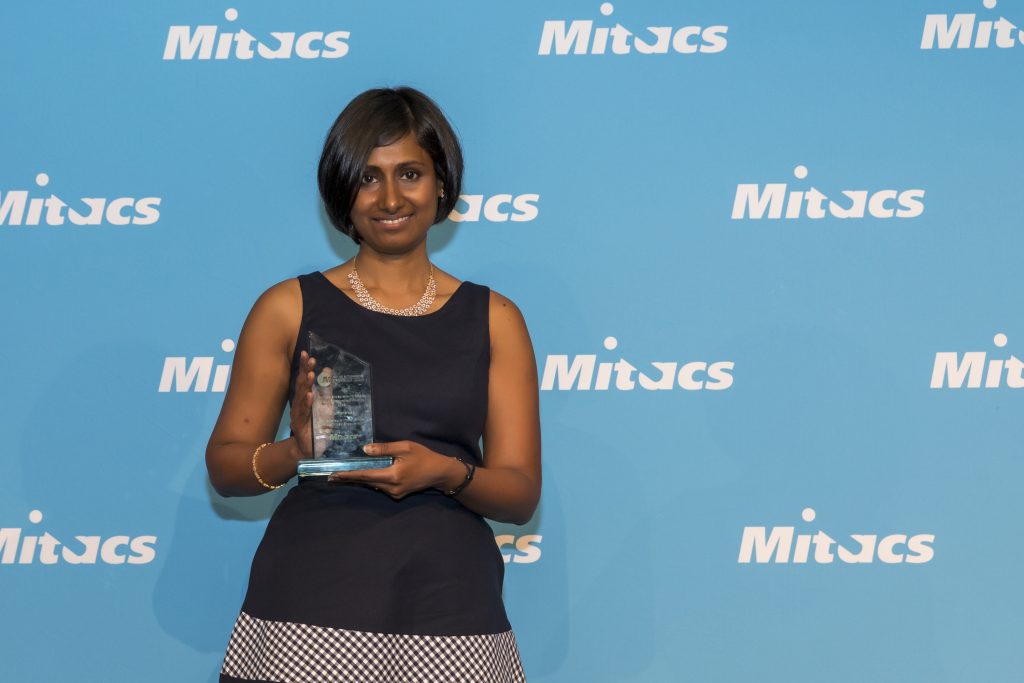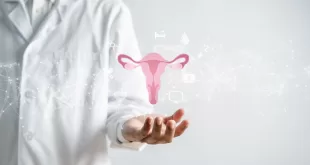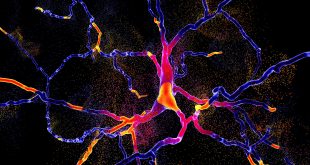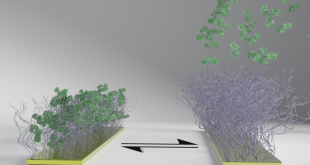By Jana Manolakos
She’s a trail blazer – a passionate inventor and founder of a company with a mission to clear the way for critical drugs to move to market faster. Dr. Alli Murugesan applied a game-changing commercialization strategy to bypass traditional academic barriers and won the Mitacs Global Impact Entrepreneur Award this past June.
Together with medical oncologist and University of New Brunswick professor Dr. Tony Reiman (Canadian Cancer Society Chair) and Université de Moncton associate professor Dr. Mohamed Touaibia, she co-invented a patent-filed, nature-inspired chemical compound that targets and kills blood cancer cells, including those that have grown resistant to chemotherapy. Her company, BioHuntress Therapeutics Inc., is now seeking investment and industrial funding to begin animal testing and phase one clinical trials in humans. We spoke to the Mitacs postdoctoral fellow and senior scientist at the University of New Brunswick’s Reiman Cancer Research Laboratory about her work.
You founded BioHuntress Therapeutics Inc. in 2016 and you continue to be heavily engaged in biochemical research. What made you decide to start BioHuntress?
In my academic research career, I have invented some interesting new molecules and have observed new behaviours among known ones. I always wondered what it would take for ideas born in the laboratory to become useful applications for the benefit of society. It was this deep contemplation that compelled me to become a nexus between academia and industry.
What is your company’s vision?
The vision of my company is to develop novel, well-tolerated drugs for blood cancers and resorptive bone diseases. The long-term vision of BioHuntress is to further establish itself as a sustainable incubator within academia and to aid academic researchers in articulating their value propositions, connecting with key partners and identifying channels to realize a drug.
As a fledgling incubator, BioHuntress helps researchers identify ideas that can be commercialized, and helps them cross that last mile by articulating value propositions, bringing key partners and identifying commercialization channels – and in the process reducing the time to market significantly.
You were presented the Mitacs Global Impact Entrepreneur Award in Montreal in June. What did that mean to you?
As a researcher, especially somebody who dreams to invent new things, to even be associated with the words “global impact entrepreneur” is a big honour and I found that award to be a great inspiration and a humbling moment. Entrepreneurship is not often recognized, so Mitacs is wonderful in showcasing such entrepreneurial researchers. I am very privileged to receive this award.
Why do you suppose entrepreneurship sometimes takes a back seat in academia?
If you look at classical investigative approaches, our goal as researchers is to ask questions; we put our time and energy into research and publishing the findings. Commercialization involves a lot of time and different types of resources and skills. My strategy involves deferring traditional academic publishing in favour of pursuing intellectual property and product development channels first.
Is this a new paradigm in research thinking?
As researchers, let’s ask ourselves before starting a new project, could we approach this differently? Publishing and patenting or commercializing is not mutually exclusive. It is possible to devise a plan for publishing as part of the research findings, and at the same time protect the findings by filing a patent. This allows you to take the commercialization path first, followed by publication of those findings. Both of these could be included in step one of the research project.
The new compound you and two other researchers – Dr. Reiman and Dr. Touaibia – invented is referred to as “nature-inspired”.
Can you explain what you mean by that?
As scientists we observe, learn and derive inspiration from nature. Natural products from medicinal plants and other natural sources are valuable in identifying new treatments for disease. Systematic biological activity-guided isolation of active principles and obtaining the desired quantity of bioactive components are some of the challenges we face in utilizing these natural products.
So what are some other approaches? Can we learn and identify the key scaffolds, the structural backbone from those natural products and synthesize them in the laboratory, as compounds with potent and better effects?

Tell me about the moment when you realized the potency of your invention.
In the preclinical studies we took human blood cancer cells and treated them with these nature-inspired chemical compounds. At different stages we began to see the effect the compounds were having so those are all moments when you get excited. My passion has always been to find a cure – a novel treatment for myeloma bone cancer. It’s a very complicated disease that when you think you have treated it, comes back. To see the ability of our compound to kill the existing chemo-resistant cells in these preclinical studies is very exciting for me. I would be extremely delighted to see similar results in animal models. That’s the next step.
Time for people is of the essence when faced with devastating diseases. How long before the compound enters the market?
In North America it takes an average of 12 years for an experimental drug to travel from the laboratory to market. For example, only five in 5,000 drugs that enter the pre-clinical testing stage make it to human testing. Out of those five, maybe one will be approved. So its miles to go before I sleep, but I am very positive and taking an approach where this discovery, through BioHuntress, can drive collaboration between industry and academia to advance the preclinical studies further in animal models which we will complete in two years and then proceed to phase one clinical trials. There is so much energy and drive in advancing this and we really need investors to help us take it further.
You arrived in Canada in 2006. Tell us a bit about how you started in this field?
I came from Pondicherry, India. If you have read the Life of Pi, Pi hales from Pondicherry. It’s a little French colony. I’m a curious adventurer and always wanted to travel everywhere. My parents were headmasters and it was their open-mindedness and liberal thinking that allowed me to travel and be myself. I owe everything to them. I did my PhD in biotechnology and am a chemist by training and later became a biotechnologist. Everytime you acquire new information, go into a new area of research or work on a new disease model, you apply your interdisciplinary knowledge and expertise. For example, I began working on anti-diabetic models – that’s what my PhD was in, and looked for medicinal plants as a cure or treatment for diabetes. When I moved to Canada, I took that knowledge and applied it while exploring natural products and novel treatments. Now, I hope to add value to research teams who are focused on publishing, by offering insights into commercializing.
 BioLab Business Magazine Together, we reach farther into the Canadian Science community
BioLab Business Magazine Together, we reach farther into the Canadian Science community





